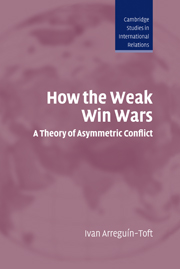Book contents
- Frontmatter
- Contents
- List of figures
- Preface
- Acknowledgments
- List of abbreviations
- 1 Introduction
- 2 Explaining asymmetric conflict outcomes
- 3 Russia in the Caucasus: the Murid War, 1830–1859
- 4 Britain in Orange Free State and Transvaal: the South African War, 1899–1902
- 5 Italy in Ethiopia: the Italo-Ethiopian War, 1935–1940
- 6 The United States in Vietnam: the Vietnam War, 1965–1973
- 7 The USSR in Afghanistan: the Afghan Civil War, 1979–1989
- 8 Conclusion
- Appendix
- References
- Index
- CAMBRIDGE STUDIES IN INTERNATIONAL RELATIONS
6 - The United States in Vietnam: the Vietnam War, 1965–1973
Published online by Cambridge University Press: 22 August 2009
- Frontmatter
- Contents
- List of figures
- Preface
- Acknowledgments
- List of abbreviations
- 1 Introduction
- 2 Explaining asymmetric conflict outcomes
- 3 Russia in the Caucasus: the Murid War, 1830–1859
- 4 Britain in Orange Free State and Transvaal: the South African War, 1899–1902
- 5 Italy in Ethiopia: the Italo-Ethiopian War, 1935–1940
- 6 The United States in Vietnam: the Vietnam War, 1965–1973
- 7 The USSR in Afghanistan: the Afghan Civil War, 1979–1989
- 8 Conclusion
- Appendix
- References
- Index
- CAMBRIDGE STUDIES IN INTERNATIONAL RELATIONS
Summary
Everything rotted and corroded quickly over there: bodies, boot leather, canvas, metal, morals. Scorched by the sun, wracked by the wind and rain of the monsoon, fighting in alien swamps and jungles, our humanity rubbed off of us as the protective bluing rubbed off the barrels of our rifles. We were fighting in the cruelest kind of conflict, a people's war. It was no orderly campaign, as in Europe, but a war for survival waged in a wilderness without rules or laws; a war in which each soldier fought for his own life and the lives of the men beside him, not caring who he killed in that personal cause or how many or in what manner and feeling only contempt for those who sought to impose on his savage struggle the mincing distinctions of civilized warfare – that code of battlefield ethics that attempted to humanize an essentially inhuman war.
Caputo (1996)US military intervention in Vietnam began soon after the French defeat at Dien Bien Phu in 1954. The full commitment of US combat troops, however, did not occur until eleven years later. When US Marines came ashore at Da Nang in 1965 the US population was about 194 million, while North Vietnam's was approximately 19 million. US and North Vietnamese armed forces totaled approximately 2.5 million and 256,000, respectively.
- Type
- Chapter
- Information
- How the Weak Win WarsA Theory of Asymmetric Conflict, pp. 144 - 168Publisher: Cambridge University PressPrint publication year: 2005



